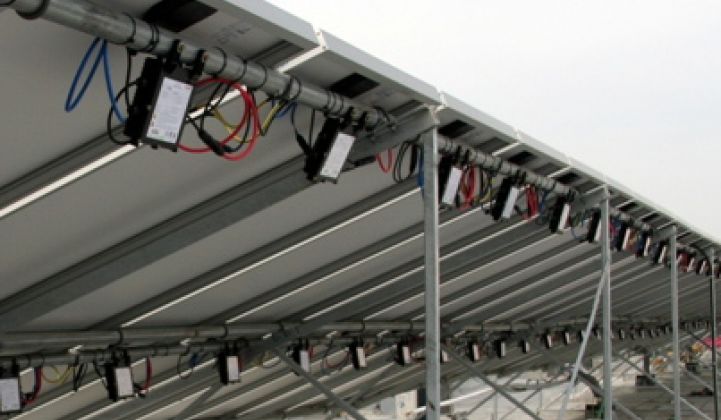SolarEdge, the market leader for U.S. residential solar inverter and optimizer sales, and microinverter maker Enphase, its distant second-place contender, both reported strong fourth-quarter 2019 earnings this week and forecast continued growth in 2020, sending their share prices up.
At the same time, both are preparing for what could be a significant impact from the coronavirus in China, which has led to massive quarantines and an economic slowdown that could affect both companies’ manufacturing and supply chains.
SolarEdge: Another record quarter and year
SolarEdge reported $418.2 million in revenue and GAAP net income of $52.8 million for the fourth quarter, both quarterly records. For fiscal year 2019, it earned a record $1.43 billion in revenue and GAAP net income of $146.5 million, marking its second consecutive year of higher than 50 percent growth on a year-over-year basis. It shipped 1.6 gigawatts of inverters in the fourth quarter, with 788 megawatts going to North America and 620 megawatts to Europe.
But on a Wednesday earnings conference call, SolarEdge CEO Zvi Lando quickly turned from these record-breaking financial results to address the effects of COVID-19 on its Chinese operations and supply chains. We’ve been tracking how the coronavirus-related disease is affecting the solar and energy storage industries, with Wood Mackenzie projecting as much as a 10 percent reduction in Chinese battery cell output for 2020.
Lando noted that SolarEdge has been preparing for a slowdown in China by building up its inventories in the fourth quarter and working closely with Jabil, its Chinese contract manufacturer, to manage supply-chain and manufacturing plans. Employees of both companies in China are healthy and working, and “we do not expect any disruption to our revenue in Q1 or Q2,” he said, although the company may continue to rely on air shipments to meet growing demand, as it has in previous quarters. SolarEdge projected first-quarter revenues of $425 million to $440 million.
The Israel-based company has grown to dominate the U.S. residential solar sector with its single-phase inverter and panel-mounted DC optimizer technology, according to Wood Mackenzie’s U.S. PV Leaderboard. SolarEdge systems were used in 60 percent of U.S. residential solar installations in the first three quarters of last year, up from about 50 percent in 2018 and about 25 percent in 2015, the year it went public.
SolarEdge is also seeing major increases in demand for its battery-compatible inverters, as part of its push into solar-storage systems, Lando said. Shipments in the fourth quarter were up 60 percent from the prior quarter, and backlog for the first quarter is more than double what it shipped in the last quarter of 2019.
SolarEdge is one of many solar industry providers seeking to consolidate its technology as a hub for behind-the-meter batteries. The company links batteries and behind-the-meter loads for Vermont utility Green Mountain Power and controls Tesla and LG batteries for Australian utility AGL’s virtual power plant project.
It has also bought uninterrupted power specialist Gamatronic, South Korean battery manufacturer Kokam and Italian electric mobility firm SMRE in the past two years to expand its product offering, though those business lines contributed only $29.2 million to its fourth-quarter revenue.
Enphase: Rebuilding and growing market share
Enphase reported fourth-quarter revenues of $210 million and GAAP net income of $116.7 million including an income tax benefit of $72.2 million, an improvement from the previous quarter. For 2019, the Petaluma, Calif.-based company reported income of $161.2 million on revenue of $624.3 million for fiscal year 2019. That’s a marked improvement from a 2018 net loss of $11.6 million on revenue of $316.2 million and highlights the microinverter maker’s continued comeback.
Enphase shipped 677 megawatts (DC) of its microinverters in the fourth quarter and projected first-quarter revenue in the $200 million to $210 million range. CEO Badri Kothandaraman said during a Tuesday conference call that the effects of the coronavirus were not expected to have a major impact on its first-quarter shipments and inventories. But, he said, “We are seeing some indications that the outbound logistics from China is constrained,” and the company is preparing to expedite products through air shipments to manage that possibility.
Enphase’s microinverters accounted for 19.2 percent of U.S. residential solar installations through the first nine months of 2019 and reached 20 percent market share in the third quarter, according to Wood Mackenzie’s U.S. PV Leaderboard. That’s the same level of market share the company commanded in the mid-2010s, before it was forced to retrench and cut costs in the face of rising competition from SolarEdge and other inverter vendors.
Enphase is also preparing to launch its Ensemble energy storage systems in March as part of its push to capture the share of home solar customers adding batteries for backup power or self-supply purposes. California’s wildfires and fire-prevention blackouts have boosted the attachment rates of batteries to solar systems in recent months, making the state an early target.




